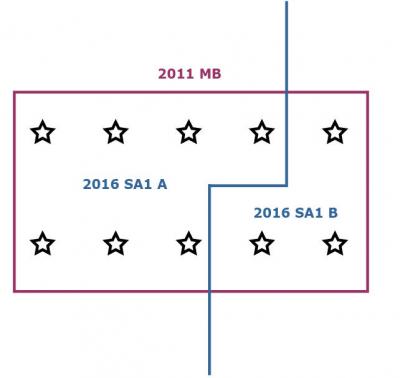Census of Population and Housing Destination Zones, August 2016 (cat. no. 8000.0)
Date of Publication/ Date Stamp: 14 December 2016
Presentation Format: Digital boundaries
Custodian
Custodian: Australian Bureau of Statistics/State and Territory Transport authorities
Description
Abstract:
The 2016 Destination Zones (DZN) are based on the 2011 Destination Zones. The 2011 Destination Zones were designed individually by each State or Territory Transport authorities. The Destination Zones are used by the States and Territories and other users for the analysis of Census Place of Work data, commuting patterns and the development of transport policy.
The 2016 Destination Zones are built out of the 2016 Mesh Blocks (MB) and align with the 2016 Statistical Area Level 2 (SA2). They do not align with the Statistical Area Level 1 (SA1)
File structure
File nomenclature:
File names have the format DZN_2016_AUST where:
- <DZN> represents Destination Zones the type of boundaries in these files.
- <2016> represents 2016 the year of the Australian Census of Population and Housing to which these boundaries apply.
- <AUST> indicates the data covers all of Geographic Australia as defined in the Australian Statistical Geography Standard (ASGS): Volume 1 – Main Structure and Greater Capital City Statistical Areas, July 2016 (cat. no. 1270.0.55.001).
Within the files, the States and Territories (S/T) are identified by unique one digit codes, as in the table below.
| Code | S/T |
|---|---|
| 1 | New South Wales |
| 2 | Victoria |
| 3 | Queensland |
| 4 | South Australia |
| 5 | Western Australia |
| 6 | Tasmania |
| 7 | Northern Territory |
| 8 | Australian Capital Territory |
| 9 | Other Territories |
File attributes:
All tables show file type, file name, spatial unit field and the data type.
File Type: Destination Zone (DZN)
File Name: DZN_2016_AUST
| Count | Field (mid/mif, TAB and GeoPackage) | Field (ESRI shp) | Data Type | Length |
|---|---|---|---|---|
| 1 | DZN_CODE_2016 | DZN_CODE16 | Character | 9 |
| 2 | SA2_MAINCODE_2016 | SA2_MAIN16 | Character | 11 |
| 3 | SA2_5DIGITCODE_2016 | SA2_5DIG16 | Character | 5 |
| 4 | SA2_NAME_2016 | SA2_NAME16 | Character | 50 |
| 5 | STATE_CODE_2016 | STE_CODE16 | Character | 1 |
| 6 | STATE_NAME_2016 | STE_NAME16 | Character | 50 |
| 7 | AREA_ALBERS_SQKM | AREASQKM16 | Float(a) |
a. Data type for ESRI Shp is Double
XML metadata file
The Destination Zone compressed download files include geospatial metadata data in Extensible Markup Language (XML) format. The geospatial metadata conforms to International Organization for Standardization (ISO) geospatial metadata standard, ISO 19115:2003, and the associated XML implementation schema specified by ISO 19139:2012.
Data currency
Date of Effect: 9 August 2016
Dataset status
Progress: Completed dataset
Maintenance and update frequency:
No further update for these boundaries are planned. The Destination Zones will be revised for the 2021 Census of Population and Housing.
Access
Stored data format:
Digital as separate files for the 2016 Destination Zones.
Available format:
The digital boundary files are in MapInfo TAB format (.TAB), MapInfo Interchange Format (.MID .MIF), Geopackage and ESRI Shapefile (.shp) format.
Spatial representation type:
Vector
Access constraints:
Copyright Commonwealth of Australia administered by the ABS. Unless otherwise noted, content is licensed under a Creative Commons Attribution 2.5 Australia licence.
Datum:
Geocentric Datum of Australia 1994 (GDA94)
The digital boundary files have the datum specified as 116 (GDA94). Users of MapInfo 6.0 or later are able to load data sets based on GDA94 directly, without transformation. Earlier versions of MapInfo cannot interpret GDA94 correctly and there may be alignment problems between data sets based on this datum and other earlier datums.
Projection:
Geographical (i.e. Latitudes and Longitudes)
Geographic extent:
Geographic Australia
Extent - Geographic bounding box:
North Bounding Latitude: -8
South Bounding Latitude: -45
West Bounding Latitude: 96
East Bounding Latitude: 169
Data quality
Lineage:
Mesh Block boundaries were created using various sources including the PSMA digital datasets and ABS boundaries, zoning information from State and Territory planning agencies and imagery.
Positional accuracy:
Positional accuracy is an assessment of the closeness of the location of the spatial objects in relation to their true positions on the earth's surface.
The positional accuracy includes:
- a horizontal accuracy assessment
- a vertical accuracy assessment
Positional accuracy for ABS boundaries is dependent on the accuracy of the features they have been aligned to. ABS boundaries are aligned to a number of layers supplied by PSMA with an accuracy of +/-50 mm.
PSMA layers and their positional accuracy are as follows:
- Transport and Topography
+/- 2 meters in urban areas and +/- 10 meters in rural and remote areas
- CadLite
+/- 2 meters in urban areas and +/- 10 meters in rural and remote areas
- Administrative Boundaries
Derived from the cadastre data from each Australian State and Territory jurisdiction
- Greenspace and Hydrology
90% of well-defined features are within 1mm (at plot scale) of their true position, eg 1:500 equates to +/- 0.5 metre and 1:25,000 equates to +/- 25 metres. Relative spatial accuracy of these themes reflects that of the jurisdictional source data. The accuracy is +/- 2 metres in urban areas and +/- 10 metres in rural and remote areas. No "shift" of data as a means of "cartographic enhancement" to facilitate presentation has been employed for any real world feature.
Attribute accuracy:
All codes and labels for the 2016 Destination Zone are fully validated.
Logical consistency:
Regions are closed polygons. Attribute records without spatial objects have been included in the data for administrative purposes.
Completeness:
All geographic levels of the 2016 Destination Zones are represented.
Contact information
Contact Organisation: Australian Bureau of Statistics
Contact: For further information email client.services@abs.gov.au or contact the National Information and Referral Service (NIRS) on 1300 135 070.

